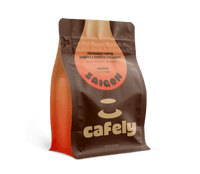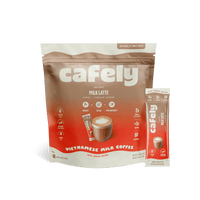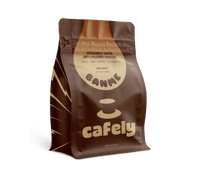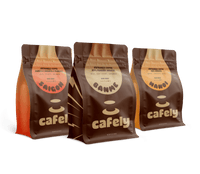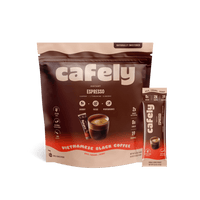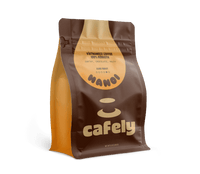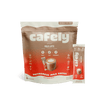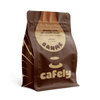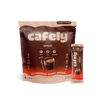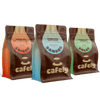Vietnamese cold brew coffee is the perfect summer beverage. Slow-brewed in cold water overnight and combined with ice and condensed milk, this drink delivers a potent hit of caffeine to get your day started on a high note.
Is this cold brew coffee the same as Vietnamese iced coffee? No, it’s not. Traditional cà phê sữa đá (Vietnamese iced coffee) is brewed hot and cooled over ice. The flavors are notoriously bold and robust, but balanced.
Vietnamese cold brew has a smoother, milder flavor and requires some extra time to prepare it.
For this recipe, you’ll need to prepare some cold brew coffee in advance.
You can use robusta beans for a stronger, more caffeinated brew (check out our HaNoi blend); arabica for smoother, more aromatic flavors (check out our DaLat blend); or a robusta/arabica blend (check out our DaNang blend) for a balance of both.
How to Brew Vietnamese Cold Brew Coffee (Summary)
Each of the recipes above require some readymade cold brew coffee. Preparing this style of coffee is simple, but requires at least 18 hours for the brew to finish steeping.
Here’s the rundown on brewing cold brew coffee in advance so you can enjoy a delicious cup of Vietnamese iced coffee in seconds.
This basic guide was derived from our full post on how to make cold brew coffee at home.
Step 1: Grind & Measure the Coffee
Start by grinding your whole-bean coffee using a coarse setting. It should have a similar consistency to sea salt.
The amount of coffee you should use will depend on the size of your brewing device:
|
Servings of Vietnamese Cold Brew |
Amount of Coffee |
Amount of Water |
|
2 (12 oz | 350 mL) |
5 tablespoons (27 g) |
7 oz (220 mL) |
|
4 (17 oz | 500 mL) |
8 tablespoons (45 g) |
12 oz (350 mL) |
|
8 (34 oz | 1000 mL) |
15 tablespoons (80 g) |
22 oz (650 mL) |
|
12 (51 oz | 1500 mL) |
24 tablespoons (125 g) |
34 oz (1000 mL) |
Step 2: Steep Your Coffee Overnight
Add your grounds and some cool or lukewarm water to a glass pitcher, jar, French press, or any other vessel.
Place it in the refrigerator and let it sit for at least 18 hours (24 hours is even better).
Step 3: Strain & Store
Pour the coffee into another container using a cheesecloth or other mesh or fabric strainer. The cold brew should last for up to two weeks in the fridge as long as it's covered.
5 Delicious Vietnamese Cold Brew Coffee Recipes
Once you've got your cold brew coffee ready, all that's left to do is mix it together!
Here are 5 recipes for making delicious Vietnamese-style coffee with your cold brew coffee — including traditional recipes, vegan-alternatives, and a boozy brunch version with Kahlua.
1. Traditional Vietnamese Cold Brew Coffee (With Condensed Milk)

This is the most traditional recipe for making cold brew Vietnamese coffee — using concentrated cold brew coffee, sweetened condensed milk, and ice.
Most people who drink Vietnamese cold brew will prepare large batch of pure robusta or a robusta-arabica blend cold brew once per week and store it in the fridge. You can then pour 4–6 ounces from this stock per cup as needed.
Preparing your coffee this way is virtually instant — the brewing process is already done, so all you have to do is mix it with ice and condensed milk.
What You Need:
- 4–6 ounces (120–150 mL) of cold brew coffee
- 2–3 ounces (60–100 mL) of sweetened condensed milk
- Plenty of ice
- A glass cup
Instructions:
- Pour your condensed milk into the bottom of an empty glass cup
- Fill the rest of the cup with ice
- Slowly pour your coffee over the ice so it forms a separate layer over the condensed milk.
- Serve, stir, & enjoy!
If you want to get the best presentation of your coffee, try to keep the coffee and condensed milk layers separate. This is how Vietnamese coffee is typically served in Vietnam.
However, prior to drinking, make sure you thoroughly stir so the layers become homogenized.
2. Vietnamese Iced Coconut Coffee

This tasty coconut coffee recipe offers a dairy-free alternative to the traditional recipe — swapping a sweetened coconut cream instead of condensed milk.
For this recipe, you'll need to find some sweetened coconut cream or make it yourself (check out our delicious coconut creamer recipe here).
What You Need:
- 4–6 ounces (120–150 mL) of cold brew coffee
- 2–3 ounces (60–100 mL) of sweetened coconut milk
- Plenty of ice
- A glass cup
Instructions:
- Pour the coconut milk into the bottom of a glass
- Fill the rest of the cup with ice
- Pour your coffee into the glass, allowing the layers to remain separated
- Serve, stir, & enjoy!
Related: How to Make Vegan Vietnamese Coffee
3. Vietnamese Egg Foam Cold Brew

This delicious egg foam coffee recipe has a deliciously silky and sweet flavor. This recipe comes straight from Vietnam.
Check out our full guide for more thorough instructions on how to make the creamy egg foam used for this coffee.
What You Need:
- 4–6 ounces (120–150 mL) of cold brew coffee
- 2 egg yolks
- 2–3 ounces (60–100 mL) of condensed milk
- Plenty of ice
- A glass cup
- A whisk or electric mixer
Instructions:
- Separate the egg yolks and or mix them together with the condensed milk until it forms a thick foam
- Add your cold brew coffee to the bottom of a glass cup
- Fill the rest of the cup with ice
- Gently pour the egg foam into the cup.
- Serve, stir, & enjoy!
4. Sea Salt Cold Brew Coffee (Iced Shakerato)

Vietnamese sea salt coffee (AKA shakerato coffee) can be prepared iced using cold brew coffee as well. This recipe follows the same process as traditional Vietnamese coffee but with the addition of some sea salt to further enhance the intensity of flavors.
What You Need:
- 4–6 ounces (120–150 mL) of cold brew coffee
- 2–3 ounces (60–100 mL) of sweetened condensed milk
- A pinch of salt
- Plenty of ice
- A glass cup
Instructions:
- Pour your condensed milk into the bottom of an empty glass cup
- Add a pinch or two of salt
- Fill the rest of the cup with ice
- Slowly pour your coffee over the ice so it forms a separate layer over the condensed milk.
- Serve, stir, & enjoy!
5. The Bruncher (Cold Brew + Kahlua)

This recipe uses a combination of robusta or robusta-arabica blend cold brew coffee with Kahlua and condensed milk (or coconut cream) for a more saucy, brunch-worthy coffee.
What You Need:
- 4–6 ounces (120–150 mL) of cold brew coffee
- 1–2 shots of Kahluah
- 2–3 ounces (60–100 mL) of condensed milk (swap for coconut cream for a dairy-free version)
- Plenty of ice
- A glass cup
Instructions:
- Pour the condensed milk or coconut into the bottom of a glass
- Fill the cup with ice
- Drop 1–2 shots of Kahlua over the ice
- Pour the rest of the coffee into the cup. Pour slowly so it forms a separate layer from the condensed milk.
- Serve, stir, & enjoy!
Expert Tips & Tricks: Vietnamese Cold Brew Coffee

Iced coffee and cold brew coffee are often called the same thing, but you’ll know a true cold brew coffee once you taste it.
Here are the top 6 tips for making the best Vietnamese cold brew coffee:
- Start with quality coffee beans — Whether you're making a cold brew or authentic Vietnamese cold brew coffee, you need to start with quality coffee beans. You can use any quality robusta or arabica coffee beans. Try using our HaNoi Coffee (100% Robusta) or DaNang Coffee (Arabica x Robusta).
- Use the proper grind — Coarsely ground coffee is a must since it provides the best extraction during the steeping process and leaves no bitter aftertaste. Remember, it needs to be the texture of ground salt.
- Use filtered water to steep the grounds — Quality water plays a big part in the process of making any coffee.
- Don’t rush the steeping process — Plan ahead when you want to enjoy Vietnamese cold brew coffee. Cold extraction takes time, and if you rush the process, you end up with weak and/or bitter coffee.
- Be careful when straining the brew — Strain the coffee slowly and carefully. Don’t wring out your cheesecloth or push the grounds through it.
- Store it properly — Always use an airtight container and store your cold brew coffee in the fridge.
The Benefits of Vietnamese Cold Brew Coffee

Vietnamese cold brew coffee provides advantages that make drinking it worthwhile. Here are the benefits of Vietnamese cold brew coffee.
1. Cold Brew is Easier on Sensitive Stomachs
Coffee is an acidic beverage that may stimulate indigestion, heartburn, or acid reflux. Some studies have found cold brew to be slightly less acidic, which means it may irritate your stomach less. It also contains compounds that may protect your stomach from this acidity.
2. Cold Brew Has a Smooth Flavor
The slow extraction process gives cold brew coffee a taste that other brewing methods don't achieve. Many people who don't like black coffee find they can drink cold brew with nothing added.
3. Vietnamese Coffee May Have Health Benefits
If you choose Vietnamese robusta beans, you’ll get nearly twice as much caffeine, twice as many antioxidants, and half the sugar compared to arabica beans [1].
Cold brew also contains caffeine. Different studies have indicated possible health benefits of caffeine: it may boost metabolism, lift your mood, and lower your risk of heart disease and diabetes [2].
Related: Is Vietnamese Coffee Healthy?
4. Preparing Cold Brew Coffee Takes Seconds (Once Brewed)
Once you get past the long brew time, cold brew is quick to prepare. Simply pour a cup and enjoy as is, or add the condensed milk or other extras if you prefer. It doesn't get any easier!
The Downside of Vietnamese Cold Brew Coffee

There are some downsides to making Vietnamese cold brew coffee.
Here’s how to deal with negatives so you can enjoy this brew.
1. Brewing Takes A Long Time
It seems like 24 hours is a long time to wait for a cup of coffee, but this step is absolutely vital and one you don’t want to rush.
The saving grace here is that you can prepare enough coffee for a full week at a time.
Start your cold brew on a Saturday afternoon and let it steep until Sunday. You’ll have cold brew coffee you can use all week. It’s like meal prep for coffee lovers!
2. Cold Brewing Uses More Coffee Per Cup
Cold brewing is less efficient than hot brewing — so you’ll need to use more coffee for one cup than other methods. This can get expensive if you're using high-quality beans.
3. High Caffeine Levels
The long brew time allows for maximum caffeine extraction. Regular cold brew has a large amount of caffeine — about 100 mg in an eight-ounce cup. Just two ounces of Vietnamese coffee can have 70 mg, and eight ounces of regular drip coffee can have about 80 mg.
This isn’t necessarily a drawback, but it’s something to be aware of — the recommended daily limit for caffeine is 400 mg.
FAQs: Vietnamese Cold Brew Coffee

1. What makes Vietnamese cold brew coffee special?
Vietnamese coffee cold brew is made by steeping bold Vietnamese coffee and water. Standard brewing methods require hot water. The steeping process — which should be at least 18 hours — creates a smooth coffee that’s less acidic. It’s then combined with water (optional) and sweetened condensed milk. Vietnamese coffee has a unique flavor that’s hard to beat.
2. What coffee beans work best for Vietnamese cold brew coffee?
While you can use any kind of coffee for cold brew, Vietnamese cold brew needs authentic Vietnamese coffee beans. There are many kinds to choose from, such as a strong robusta, a milder and authentic taste of arabica, a smooth and unique peaberry coffee, or a well-balanced blend.
Experiment with different kinds and see which you prefer.
3. What’s the difference between Vietnamese iced coffee & Vietnamese cold brew coffee?
Both are made with the best Vietnamese coffee beans, but they’re prepared using different brewing methods.
Vietnamese iced coffee is made with a phin filter and then served over ice. Vietnamese cold brew coffee is made by steeping coarse ground Vietnamese coffee with water for up to 24 hours, then combining a cup of it with sweetened condensed milk.
Related: How Much Caffeine is in Vietnamese Coffee?
4. How many calories are in a cup of Vietnamese cold brew coffee?
Coffee contains very few calories, so the calories in Vietnamese cold brew coffee come from the addition of sweetened condensed milk.
Condensed milk can contain about 20 calories per tablespoon, so a serving of Vietnamese cold brew coffee could have 40-80 calories, depending on how much condensed milk you like to add.
5. Can you make Vietnamese cold brew coffee with a French press?
Yes, you can also use a French press to make cold brew.
After grinding the beans to a coarse grind, add them to the French press with the water. Give them a stir and place the press in the fridge, covered with plastic wrap or aluminum foil. After the steeping process, you can push the press down to separate the grounds from the coffee and proceed with the Vietnamese cold brew coffee recipe.
It is preferable to use an airtight container, however, as odors and flavors from other food in the fridge may seep into the coffee in the French press. You may also get some grounds in your concentrate unless you decide to use a cheesecloth instead of the French press to do the straining.
6. How long does Vietnamese cold brew coffee keep in the fridge?
The cold brew concentrate can be stored in the fridge in an airtight container for up to 14 days, though it’s best to use it within the first week. If you make a batch of Vietnamese cold brew coffee with sweetened condensed milk, you should use it up within 3-4 days.
7. What if I don’t have time to steep the grounds to make Vietnamese cold brew coffee?
You can make Vietnamese iced coffee if you want a cold coffee but don't want to wait to steep the grounds. Vietnamese iced coffee is made by brewing coffee with a phin filter and then cooling it and serving it over ice with sweetened condensed milk. It can be made in about 10 minutes.
8. What can I use instead of cheesecloth to strain the Vietnamese cold brew coffee?
Cheesecloth is a common thing to use, but there are filter bags specifically made for brewing cold brew coffee. These are like reusable tea bags but much larger.
If you don’t have either of those, you can use other household items as a replacement. A non-disposable coffee filter is one option; a square of thin cotton is also possible, or you can use a (clean!) sock or pantyhose.
If you have a French press or a very fine mesh strainer, those can work as well.
References
- Hasbullah, U. H. A. A. (2021, February). Antioxidant activity and total phenolic compounds of arabica and robusta coffee at different roasting levels. In Journal of Physics: Conference Series (Vol. 1764, No. 1, p. 012033). IOP Publishing.
- Butt, M. S., & Sultan, M. T. (2011). Coffee and its consumption: benefits and risks. Critical reviews in food science and nutrition, 51(4), 363-373.
